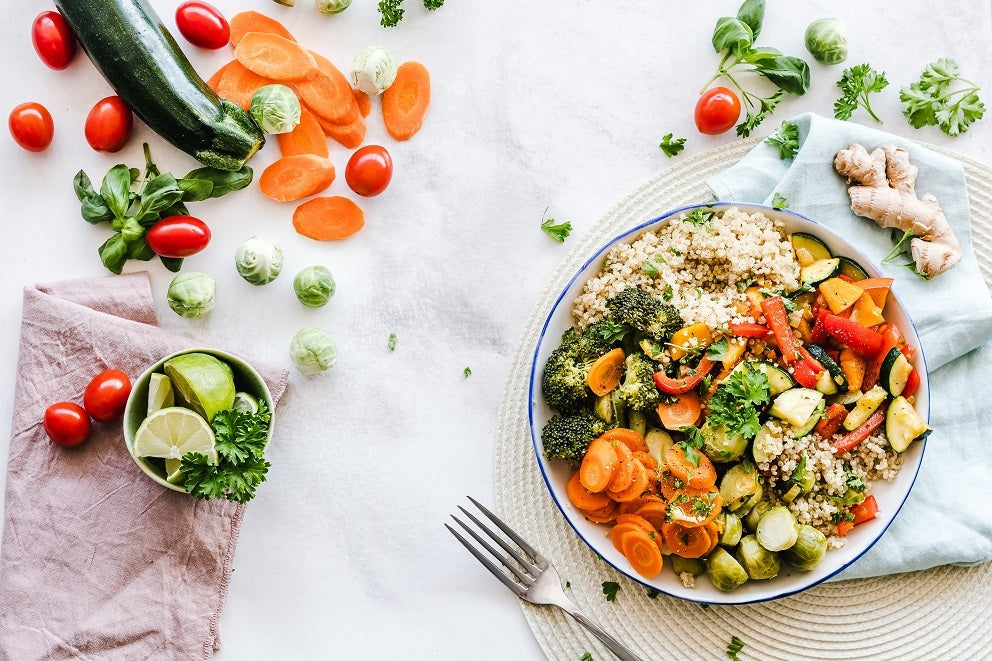For many women, the symptoms of perimenopause and menopause can be frustrating and can affect everyday life. Though there are options available to medically treat menopause, for women who are looking for an alternative, many symptoms can be helped by using natural compounds to help target and support the hormones that are changing during menopause. A group of these natural compounds, called phytoestrogens, are currently attracting attention for the potential of their oestrogen-mimicking properties as a way to treat menopause.
It can be hard trying to find clear guidance on how phytoestrogens work, and what they can do for your body. Read on for advice and answers from Health & Her’s expert nutritionist, Helen Roach, on what phytoestrogens are, how they work, and why they could be an option for you.
What is phytoestrogen?
Phytoestrogens are naturally-occurring compounds found in plants that belong to a group of substances called polyphenolic compounds. They have a similar chemical structure to oestrogen and often behave in a similar way when ingested into the body. Like HRT (Hormone Replacement Therapy), some nutritionists believe that increasing your phytoestrogen intake during perimenopause and menopause can help relieve symptoms caused by fluctuating oestrogen.
How do phytoestrogens work?
Phytoestrogens attach to oestrogen receptors, potentially creating a change in hormone and enzyme levels. They can mimic oestrogen in the body, and when phytoestrogens enter the body, the body’s oestrogen receptors attach to them as they would normal oestrogen, albeit less firmly, helping make up a deficit of oestrogen common during perimenopause and menopause. Additionally, it is thought that phytoestrogens can block oestrogen and xenoestrogens (man-made oestrogens found in skincare, industrial products and plastics, food, insecticides and building supplies) when they reach excessive levels.
Phytoestrogens and menopause symptoms
Phytoestrogens are doubly beneficial as they help maintain the right balance of oestrogen – low oestrogen is behind some of the most difficult symptoms of perimenopause and menopause, such as hot flushes, night sweats, palpitations, headaches, insomnia and sleep problems, fatigue, bone loss and vaginal dryness, plus more. And excess or high levels of oestrogen has been said to pose health risks including breast or uterine cancer. In addition, if high levels of oestrogen are present during perimenopause or menopause, it can cause bloating, breast tenderness, and heavy bleeding. Consuming phytoestrogens such as those found in fermented soy and red clover isoflavones may work to help women achieve a healthy balance to both raise and regulate their oestrogen levels.
Here are more tips to help you enjoy a healthy hormone balancing diet in menopause.
What are the benefits of phytoestrogens for menopause?
A question commonly asked is ‘do phytoestrogens help with menopause?’. Well, current research indicates that phytoestrogens affect women in perimenopause and the early stages of menopause. In countries where women tend to have a diet rich in phytoestrogens – such as Japan – research suggests a lower incidence of difficult menopausal symptoms, such as hot flushes, and a lower risk of breast and uterine cancer and osteoporosis. A 2014 study indicated that phytoestrogens reduced the frequency and severity of hot flushes in menopausal women, alongside a 2011 study that found that phytoestrogens helped in preventing osteoporosis in menopausal and post-menopausal women. Other studies have indicated that phytoestrogens may play a part in aiding heart health and preventing the growth of breast cancer cells, though more research is needed for both of these claims.
For some women, starting HRT can come with a set of challenges, or be inaccessible altogether – either the side effects are difficult, or it can’t be used due to a family history of breast cancer. In these cases, phytoestrogens can provide an alternate route to explore. However, it is important to remember that phytoestrogens bind less firmly to the body’s oestrogen receptors than traditional synthetic and body-identical oestrogen, and as a result, can be weaker in their effect. You should always visit a healthcare professional if you are struggling with severe perimenopausal and menopausal symptoms to discuss what treatment options are right for you.
Phytoestrogens can also help with postmenopausal hirsutism (the abnormal growth of hair on the face and body). Androgen hormones are responsible for male pattern hair growth and come about as the result of testosterone dominance. When hormones fluctuate during perimenopause and menopause, and as oestrogen levels are depleted after menopause, testosterone can dominate, leading to increased androgen production, facial hair growth, and thinning of hair on the head. Phytoestrogens can help to balance overall hormone levels, and when used alongside Vitamin B6 and specific herbs like Saw Palmetto, can reduce androgen production.
Are there any disadvantages to taking phytoestrogens?
We naturally consume phytoestrogens every day, in a lot of the foods we eat, and indeed, people who have a diet rich in phytoestrogens tend to be eating whole, natural foods, and thus demonstrate improved levels of health. However, though phytoestrogens may be an option to explore for women looking for alternatives for Hormone Replacement Therapy, phytoestrogens have similar properties and benefits to synthetic oestrogens, and as a result, may have similar side effects, albeit at a reduced rate. This may include an increased risk of obesity or problems with ovary function. Despite this, it is very difficult to consume phytoestrogens to a harmful level through diet and supplements, and it is not clear from any medical research that consuming them have any negative side effects.
Phytoestrogen-rich foods for menopause
You are likely consuming phytoestrogens already and simply don’t know it – especially if you are vegan or vegetarian. A plant-based diet often contains phytoestrogen-rich foods to help with menopause, as phytoestrogens are often present in food used as meat substitutes, especially those derived from soy, such as tempeh and tofu. These compounds tend to fall into three distinct categories, and as such, are found in different groups of food:
- Isoflavones – found in soybeans, soy nuts, tempeh and red clover
- Coumestans – found in peas, beans (including soya), brussel sprouts, alfalfa and clover sprouts
- Lignans – mainly found in seeds such as flaxseed and pumpkin
There are 5 main isoflavones found in soy or soy products. These include genistein, daidzein and glycitein, formononentin, and biochanin A. It is thought that the forms of isoflavone found in fermented soy products are the most effective form. The best option in terms of dietary phytoestrogens is fermented soy, as the phytoestrogens within it are thought to be more bioavailable due to the fermentation process it undergoes. Fermentation is particularly beneficial for digestion as the lactic acid bacteria flourish in your gut. Increased gut bacteria leads to better digestion by lessening the incidence of bloating/indigestion, as well as increasing the production of serotonin (the feel good hormone which is also instrumental in the production of melatonin, which helps you sleep) and most interestingly, could help to heighten the impact of phytoestrogen activity through specific enzyme production. However, fermented soy doesn’t always taste great! Don’t worry, though – you don’t have to switch to a diet solely comprised of fermented soy. Phytoestrogens are quite common in our diet and are derived from whole grains, seeds, beans, root vegetables and soy.
Foods high in phytoestrogen include;
- Seeds – such as linseeds or flax, pumpkin, sunflower, poppy, and sesame
- Whole grains – such as rye, oats, and barley
- Bran – such as wheat, oat, and rye
- Beans and lentils – such as chickpeas, kidney beans, lima beans, mung beans, pinto beans, and split peas
- Fruits – especially apples and berries
- Soybeans and soy products – tempeh, soybeans, and tofu
- Vegetables – especially cruciferous vegetables such as broccoli, cabbage, and Brussels sprouts
How much phytoestrogen food should you eat?
A portion of fermented soy foods every day would offer a good level of phytoestrogen support. If fermented soy is not something suited to your palette or tastes, a phytoestrogen supplement made up of soy or red clover will provide an effectual equivalent volume.
Here’s everything you need to know about diet for perimenopause.
Phytoestrogen supplements for menopause
Phytoestrogens can also be found in supplement form, such as the presence of Red Clover in the Health & Her Perimenopause Supplement and Health & Her Menopause Supplement. Red Clover (Trifolium pratense) is a flowering plant belonging to the legume family. It has been used in traditional medicine to treat a variety of symptoms including coughs and colds, and as a blood purifying tonic most recently revered for its phytoestrogen content. These menopause phytoestrogen supplements work to complement the existing phytoestrogens you eat and ensure you are receiving an adequate
It is important to remember that making lifestyle changes such as eating healthily, with a diet rich in phytoestrogens, can improve your quality of life and may make a difference if you are experiencing difficult menopause symptoms. However, if you are struggling severely with menopausal symptoms, you should visit a qualified medical professional to discuss and outline all your potential treatment options. Despite this, phytoestrogens indicate some real benefits in helping treat the difficult side of perimenopause and menopause and aiming for a diet that includes them could potentially do some real good.



